The Renal Cyst Treatment Market is estimated to be valued at USD 203.2 million in 2025 and is projected to reach USD 331.0 million by 2035, registering a compound annual growth rate (CAGR) of 5.0% over the forecast period.
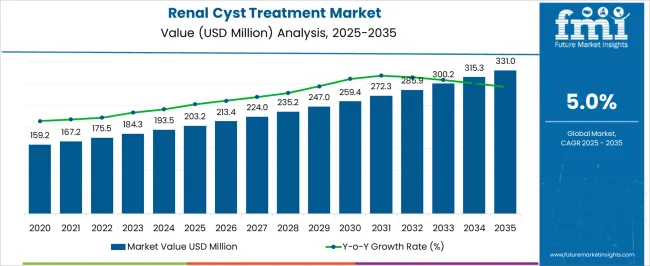
| Metric | Value |
|---|---|
| Renal Cyst Treatment Market Estimated Value in (2025 E) | USD 203.2 million |
| Renal Cyst Treatment Market Forecast Value in (2035 F) | USD 331.0 million |
| Forecast CAGR (2025 to 2035) | 5.0% |
The Renal Cyst Treatment market is experiencing steady expansion, driven by the increasing prevalence of polycystic kidney disease and related renal disorders, alongside growing awareness of early detection and management strategies. The current market landscape is shaped by advances in pharmacological interventions and the integration of specialized treatment protocols across healthcare systems. Rising investments in research and development have enabled the creation of targeted therapies that slow cyst progression and improve kidney function.
Increasing patient awareness, coupled with proactive screening programs, has contributed to higher diagnosis rates and subsequent treatment demand. Hospital infrastructure and clinical expertise are evolving to accommodate complex renal therapies, allowing for broader access to treatment.
The market is further supported by the growing emphasis on patient-centric care and the adoption of personalized medicine, which allows therapy regimens to be tailored to individual disease progression and patient needs As the population ages and chronic kidney disease prevalence rises, the Renal Cyst Treatment market is anticipated to maintain steady growth, with continued opportunities for innovative therapies and enhanced treatment delivery models.
The renal cyst treatment market is segmented by drug class, distribution channel, and geographic regions. By drug class, renal cyst treatment market is divided into Vasopressin Receptor Antagonists (Vaptans), Antibiotics Phosphate Binders, Angiotensin-Converting Enzyme (ACE) Inhibitors, Angiotensin II Receptor Antagonists, and Calcium Channel Blockers (CCB). In terms of distribution channel, renal cyst treatment market is classified into Hospital Pharmacies, Retail Pharmacies, and E-Commerce. Regionally, the renal cyst treatment industry is classified into North America, Latin America, Western Europe, Eastern Europe, Balkan & Baltic Countries, Russia & Belarus, Central Asia, East Asia, South Asia & Pacific, and the Middle East & Africa.
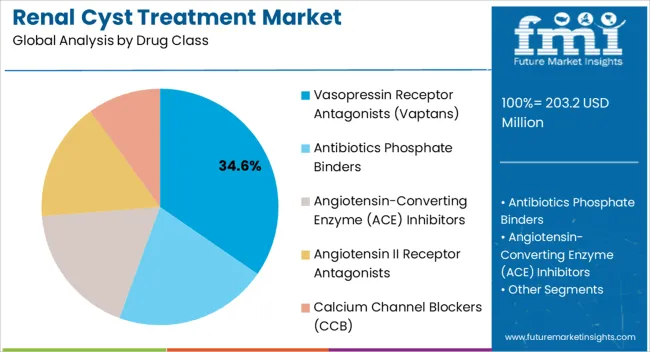
The Vasopressin Receptor Antagonists (Vaptans) drug class is expected to account for 34.60% of the Renal Cyst Treatment market revenue in 2025, establishing it as the leading pharmacological approach. This dominance is being attributed to the targeted mechanism of action, which effectively inhibits cyst growth and preserves renal function in patients with polycystic kidney disease. The efficacy of these agents in slowing disease progression has made them a preferred choice among clinicians managing complex renal conditions.
Adoption has been further accelerated by the increasing availability of clinical data demonstrating long-term outcomes and safety profiles. The convenience of oral administration and compatibility with existing treatment protocols enhances patient adherence, supporting sustained market penetration.
Additionally, the growing emphasis on personalized treatment approaches, particularly in patients with varying degrees of renal impairment, has reinforced the relevance of Vaptans as a first-line therapy Market growth is expected to continue as awareness expands among healthcare providers and patients, and as ongoing clinical research identifies broader applications for these agents in managing renal cyst disorders.
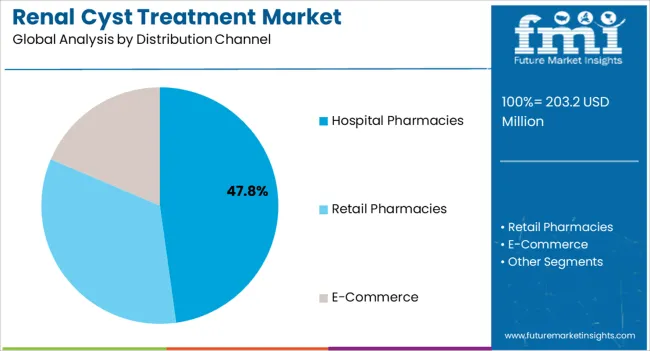
Hospital Pharmacies are projected to hold 47.80% of the Renal Cyst Treatment market revenue in 2025, making them the leading distribution channel for these therapies. This leading position is being driven by the centralized procurement and dispensing models in hospitals, which ensure consistent availability of specialized renal treatments for inpatients and outpatients alike. Hospital pharmacies are often integrated with nephrology departments, allowing direct administration and monitoring of treatment, thereby enhancing patient safety and adherence.
The reliance on hospital pharmacies has been reinforced by the need for careful dosing and monitoring protocols, particularly for high-efficacy drugs such as Vasopressin Receptor Antagonists. Furthermore, the preference for hospital-based distribution is influenced by the growing complexity of renal therapies, which require trained healthcare professionals to oversee administration and manage potential side effects.
The presence of strong hospital networks and their capacity to provide patient education and follow-up support has strengthened this segment’s dominance Continued investments in hospital pharmacy infrastructure and the expansion of nephrology services are expected to sustain the market leadership of this distribution channel in the coming years.
A renal cyst is a sack of fluid that form in the kidneys. Renal cysts generally have a thin wall and contain water like fluid. There are majorly two types of renal cyst: simple cyst and polycystic kidney disease (PKD). Renal cyst associated with PKD leads to kidney damage.
Renal cysts are usually found in older people and do not cause any symptoms or harm. In rare cases, renal cysts require treatment majorly due to infection, enlargement or bleeding. Some of the symptoms of renal cysts if it becomes infected include fever, swelling of the abdomen, blood in the urine, pain in the upper abdomen, and others. Renal cyst treatment is generally not required unless renal cysts are harming kidney functions or causing symptoms.
Renal cyst treatment includes sclerotherapy (also called percutaneous alcohol ablation) and surgery. Sclerotherapy involves the insertion of a long needle into the cyst under ultrasound guidance. Sclerotherapy is usually performed on an outpatient basis with a local anaesthetic
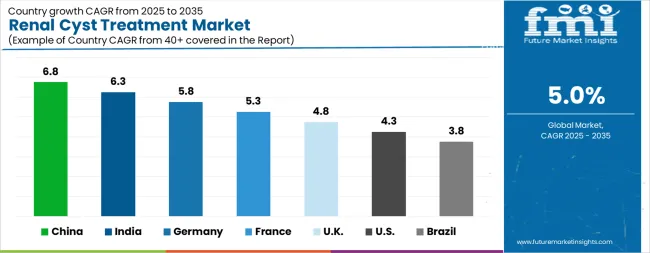
| Country | CAGR |
|---|---|
| China | 6.8% |
| India | 6.3% |
| Germany | 5.8% |
| France | 5.3% |
| UK | 4.8% |
| USA | 4.3% |
| Brazil | 3.8% |
The Renal Cyst Treatment Market is expected to register a CAGR of 5.0% during the forecast period, exhibiting varied country level momentum. China leads with the highest CAGR of 6.8%, followed by India at 6.3%. Developed markets such as Germany, France, and the UK continue to expand steadily, while the USA is likely to grow at consistent rates. Brazil posts the lowest CAGR at 3.8%, yet still underscores a broadly positive trajectory for the global Renal Cyst Treatment Market. In 2024, Germany held a dominant revenue in the Western Europe market and is expected to grow with a CAGR of 5.8%. The USA Renal Cyst Treatment Market is estimated to be valued at USD 74.5 million in 2025 and is anticipated to reach a valuation of USD 112.9 million by 2035. Sales are projected to rise at a CAGR of 4.3% over the forecast period between 2025 and 2035. While Japan and South Korea markets are estimated to be valued at USD 10.8 million and USD 5.7 million respectively in 2025.
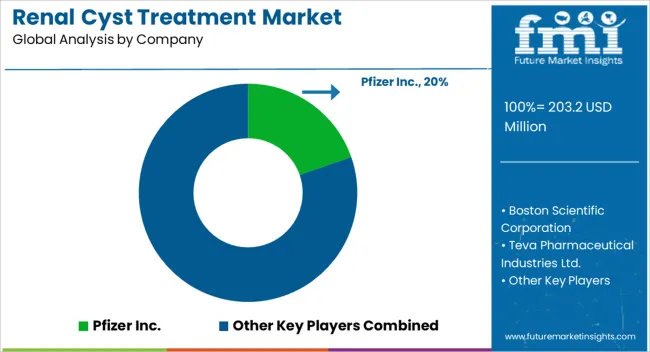
| Item | Value |
|---|---|
| Quantitative Units | USD 203.2 Million |
| Drug Class | Vasopressin Receptor Antagonists (Vaptans), Antibiotics Phosphate Binders, Angiotensin-Converting Enzyme (ACE) Inhibitors, Angiotensin II Receptor Antagonists, and Calcium Channel Blockers (CCB) |
| Distribution Channel | Hospital Pharmacies, Retail Pharmacies, and E-Commerce |
| Regions Covered | North America, Europe, Asia-Pacific, Latin America, Middle East & Africa |
| Country Covered | United States, Canada, Germany, France, United Kingdom, China, Japan, India, Brazil, South Africa |
| Key Companies Profiled | Pfizer Inc., Boston Scientific Corporation, Teva Pharmaceutical Industries Ltd., Sanofi, Allergan, Inc., Novartis International AG, Dr. Reddy's Laboratories Ltd., Amgen Inc., Merck & Co., Inc., Covidien Plc, and Baxter International Inc. |
The global renal cyst treatment market is estimated to be valued at USD 203.2 million in 2025.
The market size for the renal cyst treatment market is projected to reach USD 331.0 million by 2035.
The renal cyst treatment market is expected to grow at a 5.0% CAGR between 2025 and 2035.
The key product types in renal cyst treatment market are vasopressin receptor antagonists (vaptans), antibiotics phosphate binders, angiotensin-converting enzyme (ace) inhibitors, angiotensin ii receptor antagonists and calcium channel blockers (ccb).
In terms of distribution channel, hospital pharmacies segment to command 47.8% share in the renal cyst treatment market in 2025.






Our Research Products

The "Full Research Suite" delivers actionable market intel, deep dives on markets or technologies, so clients act faster, cut risk, and unlock growth.

The Leaderboard benchmarks and ranks top vendors, classifying them as Established Leaders, Leading Challengers, or Disruptors & Challengers.

Locates where complements amplify value and substitutes erode it, forecasting net impact by horizon

We deliver granular, decision-grade intel: market sizing, 5-year forecasts, pricing, adoption, usage, revenue, and operational KPIs—plus competitor tracking, regulation, and value chains—across 60 countries broadly.

Spot the shifts before they hit your P&L. We track inflection points, adoption curves, pricing moves, and ecosystem plays to show where demand is heading, why it is changing, and what to do next across high-growth markets and disruptive tech

Real-time reads of user behavior. We track shifting priorities, perceptions of today’s and next-gen services, and provider experience, then pace how fast tech moves from trial to adoption, blending buyer, consumer, and channel inputs with social signals (#WhySwitch, #UX).

Partner with our analyst team to build a custom report designed around your business priorities. From analysing market trends to assessing competitors or crafting bespoke datasets, we tailor insights to your needs.
Supplier Intelligence
Discovery & Profiling
Capacity & Footprint
Performance & Risk
Compliance & Governance
Commercial Readiness
Who Supplies Whom
Scorecards & Shortlists
Playbooks & Docs
Category Intelligence
Definition & Scope
Demand & Use Cases
Cost Drivers
Market Structure
Supply Chain Map
Trade & Policy
Operating Norms
Deliverables
Buyer Intelligence
Account Basics
Spend & Scope
Procurement Model
Vendor Requirements
Terms & Policies
Entry Strategy
Pain Points & Triggers
Outputs
Pricing Analysis
Benchmarks
Trends
Should-Cost
Indexation
Landed Cost
Commercial Terms
Deliverables
Brand Analysis
Positioning & Value Prop
Share & Presence
Customer Evidence
Go-to-Market
Digital & Reputation
Compliance & Trust
KPIs & Gaps
Outputs
Full Research Suite comprises of:
Market outlook & trends analysis
Interviews & case studies
Strategic recommendations
Vendor profiles & capabilities analysis
5-year forecasts
8 regions and 60+ country-level data splits
Market segment data splits
12 months of continuous data updates
DELIVERED AS:
PDF EXCEL ONLINE
Renal Insufficiency Treatment Market Analysis by End User, Treatment Type, and Region: Forecast for 2025 to 2035
Dacryocystitis Treatment Market
Congenital Adrenal Hyperplasia Treatment Market Analysis and Forecast by Type, Treatment, End User, and Region through 2035
Autosomal Dominant Polycystic Kidney Disease Treatment Market Overview - Growth & Forecast 2025 to 2035
Renal Denervation Catheter Market Size and Share Forecast Outlook 2025 to 2035
Treatment-Resistant Hypertension Management Market Size and Share Forecast Outlook 2025 to 2035
Treatment-Resistant Depression Treatment Market Size and Share Forecast Outlook 2025 to 2035
Cystic Fibrosis Therapeutics Market Size and Share Forecast Outlook 2025 to 2035
Cystatin C Testing Market Size and Share Forecast Outlook 2025 to 2035
Renal Function Test Market Growth - Trends & Forecast 2025 to 2035
Treatment Pumps Market Insights Growth & Demand Forecast 2025 to 2035
Renal Biomarker Market Report – Trends & Forecast 2024-2034
Adrenal Crisis Management Market Analysis and Forecast, By Diagnosis Method, Treatment Method, Distribution Channel, and Region, through 2035
Pretreatment Coatings Market Size and Share Forecast Outlook 2025 to 2035
L- Cysteine Market
Air Treatment Ozone Generator Market Size and Share Forecast Outlook 2025 to 2035
CNS Treatment and Therapy Market Insights - Trends & Growth Forecast 2025 to 2035
Homocysteine Testing Market
Seed Treatment Materials Market Size and Share Forecast Outlook 2025 to 2035
Acne Treatment Solutions Market Size and Share Forecast Outlook 2025 to 2035

Thank you!
You will receive an email from our Business Development Manager. Please be sure to check your SPAM/JUNK folder too.
Chat With
MaRIA